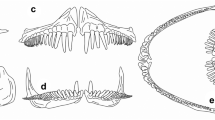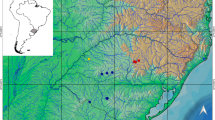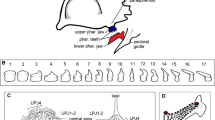Abstract
Parrotfish are amongst the most abundant teleost species in the Gulf of California, and yet their feeding ecology and the impact they have on the reef ecosystems in this region remain unknown. Here, a well-established computational model of jaw biomechanics in fishes (MandibLever 4.0) was used to simulate the mandibular dynamics during feeding of the two dominant reef-dwelling parrotfish species in the Gulf of California (Scarus ghobban and S. perrico), and to infer, to some extent, their potential ecological role. A total of 52 specimens were collected from six localities in La Paz Bay and the Los Cabos region between March and October 2015. The model predicted a greater jaw closing force and power in the bite of S. perrico, but a higher mandibular rotating velocity in S. ghobban. The calculated differences in their bite dynamics suggest that these two species may exploit different food resources, driven by food hardness. Moreover, the variation in their mandibular morphology and predicted feeding behavior might imply the presence in the Gulf of California of the two previously described functional groups found in reef-dwelling parrotfishes: excavators and scrapers. As an excavator, S. perrico would be functioning as one of the major agents of external bioerosion in the rocky reefs of the Gulf of California, whereas, as a scraper, S. ghobban would facilitate the reworking and hydrological transport of fine sediments. This work lays the foundation for future studies on the feeding ecology and impact of parrotfishes on the reefs of the Gulf of California.





Similar content being viewed by others
References
Adams J (1980) Osteological preparation techniques 2. Guild Taxidermists Newslett 5:44–50
Alfaro M, Westneat MW (1999) Motor patterns of herbivorous feeding: electromyographic analysis of biting in the parrotfishes Cetoscarus bicolor and Scarus iseri. Brain Behav Evol 54:205–222
Alwany MA, Thaler E, Stachowitsch M (2009) Parrotfish bioerosion on Egyptian Red Sea reefs. J Exp Mar Biol Ecol 371:170–176
Bellwood DR (1994) A phylogenetic study of the parrotfishes family Scaridae (Pisces: Labroidei), with a revision of genera. Rec Aust Mus Suppl 20:1–86
Bellwood DR (1995a) Direct estimate of bioerosion by two parrotfish species, Chlorurus gibbus and C. sordidus, on the Great Barrier Reef. Austral Mar Biol 121:419–429
Bellwood DR (1995b) Carbonate transport and within reef patterns of bioerosion and sediment release by parrotfishes (family Scaridae) on the Great Barrier Reef. Mar Ecol Prog Ser 117:127–136
Bellwood DR (1996) Production and reworking of sediment by parrotfishes (family Scaridae) on the Great Barrier Reef, Australia. Mar Biol 125:795–800
Bellwood DR, Choat JH (1990) A functional analysis of grazing in parrotfishes (family Scaridae): the ecological implications. Environ Biol Fish 28:189–214
Bellwood DR, Hoey AS, Choat JH (2003) Limited functional redundancy in high diversity systems: resilience and ecosystem function on coral reefs. Ecol Lett 6:281–285
Bellwood DR, Hoey AS, Hughes TP (2012) Human activity selectively impacts the ecosystem roles of parrotfishes on coral reefs. Proc R Soc B 279:1621–1629
Bonaldo RM, Krajewski JP, Sazima C, Sazima I (2006) Foraging activity and resource use by three parrotfish species at Fernando de Noronha Archipelago, tropical West Atlantic. Mar Biol 149:423–433
Bruggemann JH, van Kessel AM, van Rooij JM, Breeman AM (1996) Bioerosion and sediment ingestion by the Caribbean parrotfish Scarus vetula and Sparisoma viride: implications of fish size, feeding mode and habitat use. Mar Ecol Prog Ser 134:59–71
Burkepile DE, Hay ME (2008) Herbivore species richness and feeding complementarity affect community structure and function on a coral reef. Proc Nat Acad Sci USA 105:16201–16206
Cardoso SC, Soares MC, Oxenford HA, Côté IM (2009) Interspecific differences in foraging behavior and functional role of Caribbean parrotfish. Mar Biod Rec. doi:10.1017/S1755267209990662
Case JE, Westneat MW, Marshall CD (2009) Feeding biomechanics of juvenile red snapper (Lutjanus campechanus) from the northwestern Gulf of Mexico. J Exp Biol 211:3826–3835
Forskål P (1775) Descriptiones Animalium. Avium, amphibiorum, piscium, insectorum, vermium; quae in itinere orientali observavit Petrus Forskål. Post mortem auctoris. Edidit Carsten Niebuhr. Hauniae
Gerking SD (1994) Feeding ecology of Fish. Academic Press, Sand Diego, p 416
Higham TE (2011) Feeding Mechanics. In: Farrel AP (ed) Encyclopedia of Fish physiology: from genome to environment, vol 1. Academic Press. San Diego, California, pp 597–602
Hoey AS, Bellwood DR (2008) Cross-shelf variation in the role of parrotfishes on the Great Barrier Reef. Coral Reefs 27:37–47
Jordan DS, Gilbert CH (1882) Descriptions of thirty-three new species of fishes from Mazatlan, Mexico. Proc US Natl Mus 4(237):338–365
Laur DR, Ebeling AW (1983) Predator-prey relationships in surfperches. Environ Biol Fish 8:217–229
Lewis SM, Wainwright PC (1985) Herbivore abundance and grazing intensity on a Caribbean coral reef. J Exp Mar Biol Ecol 87:215–228
Liedke AMR, Bonaldo RM, Segal B, Ferreira CEL, Nunes LT, Burigo AP, Buck S, Oliveira-Santos LGR, Floeter SR (2017) Resource partitioning by two syntopic sister species of butterflyfish (Chaetondontidae). J Mar Biol Assoc UK. doi:10.1017/S0025315417001321
Liem KF (1980) Acquisition of energy by teleosts: adaptive mechanisms and evolutionary patterns. In: Ali MA (ed) Environmental physiology of fishes. Plenum Publishing, New York, pp 299–334
Maie T, Schoenfuss HL, Blob RW (2009) Jaw lever analysis of Hawaiian gobioid stream fishes: a simulation study of morphological diversity and functional performance. J Morphol 270:976–983
McAfee ST, Morgan SG (1996) Resource use by five sympatric parrotfishes in the San Blas Archipelago, Panama. Mar Biol 125:427–437
Mumby PJ, Dahlgren CP, Harborne AR, Kappel CV, Micheli F, Brumbaugh DR, Holmes KE, Mendes JM, Broad K, Sanchirico JN, Buch K, Box S, Stoffle RW, Gill AB (2006) Fishing, trophic cascades, and the process of grazing on coral reefs. Science 311:98–101
Nagelkerken I, Van der Velde G, Wartenbergh SLJ, Nugues MM, Pratchett MS (2009) Cryptic dietary components reduce dietary overlap among sympatric butterflyfishes (Chaetodontidae). J Fish Biol 75:1123–1143
Nanami A (2016) Parrotfish grazing ability: interspecific differences in relation to jaw-lever mechanics and relative weight of adductor mandibulae on an Okinawan coral reef. Peer J 4:e2425. doi:10.7717/peerj.2425
Rosenblatt RH, Hobson ES (1969) Parrotfishes (Scaridae) of the Eastern Pacific, with a generic rearrangement of the scarinae. Copeia 3:434–453
Schneider CA, Rasband WS, Eliceiri KW (2012) NIH Image to ImageJ: 25 years of image analysis. Nat Meth 9(7):671–675
Stearn CW, Scoffin TP, Martindale W (1977) Calcium carbonate budget of a fringing reef on the west coast of Barbados. Part I. Zonation and productivity. Bull Mar Sci 27(3):479–510
Wainwright PC (1988) Morphology and ecology: functional basis of feeding constraints in Caribbean labrid fishes. Ecology 69(3):635–645
Wainwright PC, Bellwood DR (2002) Ecomorphology of feeding in coral reef fishes. In: Sale PF (ed) Coral Reef Fishes. Dynamics and diversity in a complex ecosystem. Academic Press, Orlando, pp 33–55
Wainwright PC, Osenberg CW, Mittelbach GG (1991) Trophic polymorphism in the pumpkinseed sunfish (Lepomis gibbosus Linnaeus): effects of environment on ontogeny. Funct Ecol 5:40–55
Wainwright PC, Bellwood DR, Westneat MW, Grubich JR, Hoey AS (2004) A functional morphospace for the skull of labrid fishes: patterns of diversity in a complex biomechanical system. Biol J Linn Soc 82:1–25
Westneat MW (1990) Feeding mechanics of teleost fishes (Labridae; Perciformes): a test of four-bar linkage models. J Morph 205:269–295
Westneat MW (1994) Transmission of force and velocity in the feeding mechanisms of labrid fishes (Teleostei, Perciformes). Zoomorphology 114:103–118
Westneat MW (1995) Feeding, function, and phylogeny: analysis of historical biomechanics in labrid fishes using comparative methods. Sys Biol 44(3):361–383
Westneat MW (2003) A biomechanical model for analysis of muscle force, power output and lower jaw motion in fishes. J Theor Biol 223:269–281
Westneat MW (2004) Evolution of levers and linkages in the feeding mechanisms of fishes. Integr Comp Biol 44:378–389
Acknowledgements
We wish to thank D. Whitmore for his kind suggestions and corrections on the manuscript, J. Alvarado-Ortega for helpful discussions and assistance with images, and two anonymous reviewers whose opinions and suggestions greatly helped to enrich this article. This study is part of the Secretaría de Investigación y Posgrado-Instituto Politécnico Nacional, projects: 20141337, 20150972, 20160767 and 20170860. MPMD is grateful for the support provided by Consejo Nacional de Ciencia y Tecnología and Beca de Estímulo Institucional de Formación de Investigadores-Instituto Politécnico Nacional. AFGA, VHCE and RME thank the support of the Comisión de Operación y Fomento de Actividades Académicas-Instituto Politécnico Nacional, Estímulos al Desempeño de los Investigadores-Instituto Politécnico Nacional, and Sistema Nacional de Investigadores-Consejo Nacional de Ciencia y Tecnología.
Author information
Authors and Affiliations
Corresponding author
Ethics declarations
Conflict of interest
The authors declare that they have no conflict of interest.
Animal rights
All applicable international, national, and/or institutional guidelines for the care and use of animals were followed.
Data availability
The datasets during and/or analyzed during the current study available from the corresponding author on reasonable request.
Rights and permissions
About this article
Cite this article
Melgarejo-Damián, M.P., González-Acosta, A.F., Cruz-Escalona, V.H. et al. A comparison of feeding biomechanics between two parrotfish species from the Gulf of California. Zoomorphology 137, 165–176 (2018). https://doi.org/10.1007/s00435-017-0383-6
Received:
Revised:
Accepted:
Published:
Issue Date:
DOI: https://doi.org/10.1007/s00435-017-0383-6




